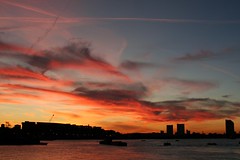Size is everything to a mayor consumed by edifice complex - a riposte (part 1)
Yesterday's ramble was a preamble to writing about the Guardian article by Simon Jenkins from the other week. Matt texted me asking what my take was, and I replied saying I didn't have one yet, but by golly I would!
So below it is
The title is what prompted yesterday's tirade. 'Edifice complex' is code for building phallic symbols, isn't it? If not, then maybe my interpretation says more about me than I would like.Size is everything to a mayor consumed by edifice complex
Londoners worldwide have no idea what is about to hit them. They have not been shown. They have not been told. Today they may stand on Waterloo bridge, look east and see a city that has been familiar to them all their lives. Tomorrow they will see something completely different, thanks to their mayor, Ken Livingstone.I doubt Londoners worldwide will today be standing on Waterloo bridge as they are most probably busying themselves with being worldwide, but even if they were, the city they see won't have been familiar to them all their lives. A lot of the skyline dates from post war years, and a lot of this is unenviable: Guy's hospital, the London stock exchange (before it's almost complete facelift) to name but two.
By the way, that 'have no idea what is about to hit them' is a key line from my favourite TV programme of all time: Shooting the Past. Watch it!
On my estimate 20 towers each more than 300ft high are planned, or proposed, to rise within half a mile of the Thames in inner London, with another 20 situated at random further back. Towers will be visible from every open space and down every street. The horizontal skyline of the capital will be transformed into a series of point blocks set in piazzas, shrinking the scale of what has always been essentially a street-based, intimate urban landscape.Towers already are visible from every open space! It's just that most of today's towers are ugly. Seeing a taller glass spire rising beyond the nearby the concrete monoliths is something, as you know, I look forward to. JOIN ME!
London intimate?! Yeah - not like the brash metropolises of the Cotswolds and the Quantocks. Let's keep London nice and quaint, the way it's always been. Our slogan: "London for the Hugh Grant's and American tourists." Does he consider St Paul's, the Tate Modern, London Eye, The Houses of Parliament to be intimate? Yes having a few intimate areas is possible in cities, but the skyline is not the place to look for intimacy!
The horizontal skyline transformation scaremongering is also molehill mountaineering. Look at most cities with skyscrapers (I haven't been to many - Boston, Toronto, Melbourne, but I can't imagine others are too different) and the skyscrapers are limited to small areas. Boston, for instance, has acres of low-rise buildings and this is the general impression you get of the city, but it is invigorating to occasionally stumble upon a taller building.
Oh, and a flat city with only low-rise buildings can't really be said to have a skyline, can it. It has a gently receding horizon, which you may want out in the country, but in the middle of a big city it isn't necessarily the landscape you would want. Sure, many cities, like Istanbul, are low-rise and proud, but they didn't have a great deal of their traditional architecture destroyed over the past 60 years. And they are hilly too. Low-rise buildings on rolling hills are reminiscent of the Giant's Causeway, but on the flat it's a little dull. The overall impression being of an extended warehouse.
Downstream of Waterloo bridge the view will be dominated by a 43-storey tower of flats opposite the Temple, approved over the summer, immediately behind the National Theatre on the South Bank. Dwarfing even the 440ft wheel of the London Eye, this building will thrust itself into every London vista from the Embankment and the Thames bridges to Trafalgar Square and St James's Park. I have yet to meet anyone aware of its coming. It is of no published architectural quality and serves no public or ceremonial purpose. It is just a block of flats.I'll have to look into this. I think someone left a comment the other day about it. It's called '123 Bankside' I think.
Beyond it will rise a visual wall of glass skyscrapers along the river's south bank, two at Blackfriars, another behind Tate Modern, a higher King's Reach tower at London Bridge and at Bermondsey the 1,000ft "glass shard", taller even than the highest structure at Canary Wharf. Behind this wall on the curve of the river will be the new City of London. The box-like blocks of the 1980s will be overwhelmed by a forest of "shape architecture", parodies of Norman Foster's Gherkin by designers eager to impress the ever pliable City planners."Parodies of Norman Foster's Gherkin" is a terrible dismissal of buildings which seek to go beyond the standard 4-walls + roof model. Is the serpentine gallery pavilion a parody of the Gherkin. Is the... damn! - out of examples! But anyway, I look forward to the days of the box-like 80's blocks being overwhelmed.
Actually, that's not quite true - you do need a balance. The Toronto skyline, with one 'shape architecture' tower (CN Tower) and lots of block towers forms a good view. Too many wacky shapes is probably a bad thing but, apart from the Walkie Talkie (which I hate) and the Helter-Skelter, there really isn't too much wackiness around. It's mostly straight lines, a lot of glass and a healthy reluctance to settle for a completely straight-laced 4-wall tower.
There will be the 1,000ft "Helter-skelter", the "Cheesegrater", the "Pinnacle" and the "Walkie-Talkie" [*edit* showing his lack of proper research here - the Pinnacle and the Helter Skelter are actually one and the same - Bishopsgate Tower]. These children's toy pastiches will be accompanied by banal Mies van der Rohe copies such as the Heron Tower. There has been no public debate or consultation on any of this. There is no vision or declared ideal of how new and old should marry in the future city. It will just happen because no authority has the guts to set individual developments in any wider context.I agree in a way with his no public consultation statement; there was a public inquiry into the Walkie Talkie but, though I tried and tried and tried, I found no way for an actual member of the public to contribute views.
There is, however, a vision and a wider context for the individual developments. I think it's called the London plan. You can quibble about whether it really does put forward a vision (It's general gist is build in the city and at train stations, and don't impinge too much on historic areas), but do we really want a vision? We're talking aesthetics here. You can't really legislate an aesthetic vision. All you can go for are a few do's and dont's, and then hope try and be sensible and avoid instances of flagrant disregard for the landscape, surroundings and populace. And what else would the vision be if not some kind of legislative planning structure: a bland platitudinous tract about cohesiveness and respect and our ancestors' graves and so on. A PR consultancy's dream assignment. And of no use whatsoever.
I shall resume the discussion later.



2 comments:
The 43-storey tower on the South Bank is not Bankside 123, but part of the Doon Street development.
http://www.coinstreet.org/doon_street.aspx
Looks pretty bland, and a bit out-of-place. It was cut down in size when Somerset House complained it would be visible from the courtyard.
Bankside 123 is further down, by the Tate, and only about 8 storeys high. The other Blackfriars buildings will be at 240 Blackfriars Road and the Beetham Tower (housing the Jumeirah Hotel).
Until the 1950's and the Festival Of Britain, the South Bank seemed to be mainly factories, docks, power stations and breweries. That's got to be some improvement?
I stand corrected.
Although I can never, and will never, condone the demolition of breweries. In the 1800's my home town (Wrexham) was known across the country for its breweries (which flourished there due to the exceptional quality of the local water (although Wrexham now has - officially - the worst tasting water in the UK)). Now there are no breweries left. The last - Wrexham lager - was demolished in 2002 I think, to make way for a retail park.
Post a Comment